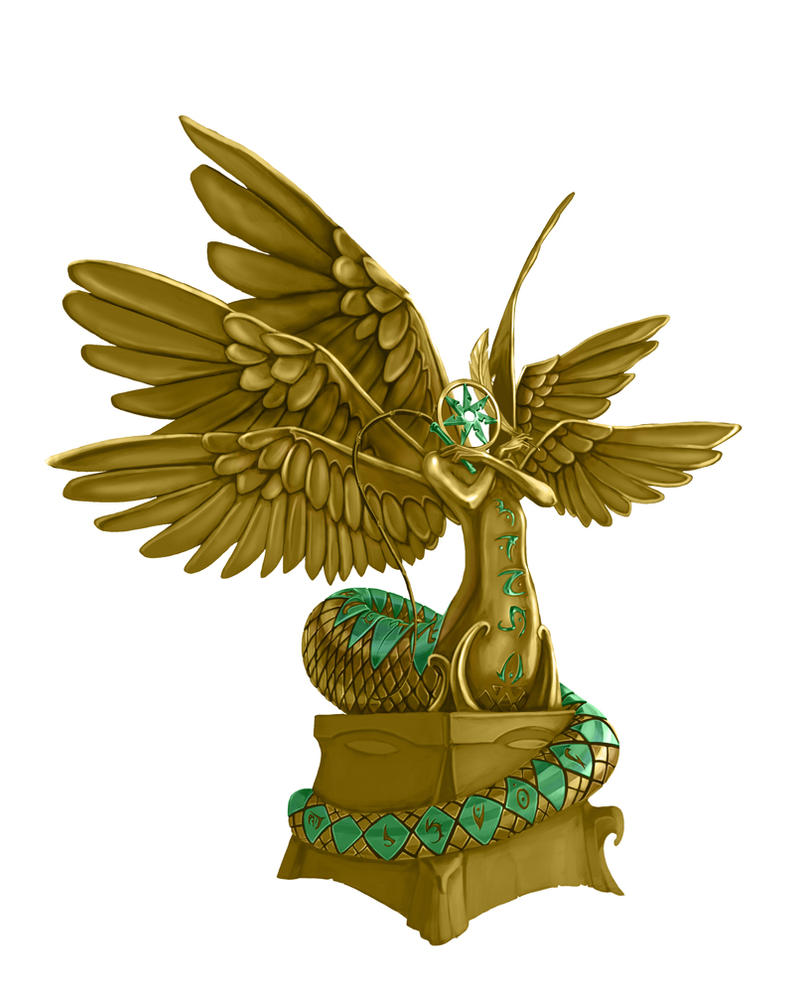Lissala
Evil, Knowledge, Law, Nobility, Rune
Ancient Azlant
Knowledge, Law, Nobility, Rune[citation needed]
Devil, Language, Leadership, Legislation, Memory, Thought, Wards
Ancient Azlant
Language, Leadership, Memory, Thought, Wards[citation needed]
|
This article might have further canon details available on StarfinderWiki. |
Lissala (pronounced lis-SALL-uh)2 is the goddess of runes, fate, and the reward of service, and was once a major religious force in the empire of Thassilon.3 She was depicted either as a stern woman with no mouth,4 or as a creature with a snake's lower half, a human woman's upper half, six wings, and a Sihedron for a head.56
History
Lissala's faith originated on Azlant, where she started off as a demigoddess whom few people understood.7
When Thassilon was founded, its First King Xin, a follower of Lissala, brought her faith to Avistan from Azlant, where it saw a renaissance.76 She taught the philosophy of the seven virtues of rule, guidelines that promised rewards for both rulers and their subjects if her teachings were strictly followed. These were eventually perverted into the seven mortal sins by the runelords; Lissala eventually embraced the evil sin magic and became a true deity. She also outlined the workings of fate to her followers. Lissala also seems to have been, if not the source, then one of the major teachers of the art of rune magic, through which the rulers of Thassilon erected their mighty works and controlled the populace.78
Near the end of Azlant and Thassilon, the Lissalan cults who stayed in Azlant dwindled in number and were regarded as heretics by the Thassilonian cults, who often sent missionaries to purge them. Krune, the final runelord of sloth, was also her final chief priest.79 During the reign of the runelords, her religion become more slavish and violent, emphasizing flagellation and mortification of the flesh.10
After Earthfall, which destroyed both Azlant and Thassilon, Lissala's cult was almost wiped out on Golarion. In 4713 AR, the Lissalans resurfaced to free their leader Krune, but he only lived long enough to be defeated and killed by agents of the Pathfinder Society.111
Relationships
Lissala was a rival of Amaznen, the other Azlanti god of magic. Their disagreement stemmed from the fact that Amaznen taught that some knowledge should be kept secret, while Lissala believed that knowledge should always be shared.12
Some Lissalan cults were enticed by the dogma of Sicva and sometimes worked alongside her followers, as both goddesses recognised the importance of duty and structure.7
Servants
Chief among Lissala's servants is her herald, Kurshu the Undying, whom she created from the parts of many different creatures.13
Unholy symbols
Lissala is known to have two types of unholy symbols: her main symbol is a variant Sihedron rune (see right); her second type was a whip twisted into the keyed rune of the particular rune magic practitioner using it.14
Church of Lissala
Those few followers remaining believe that knowledge can be gained by following a path of self-harm in an attempt to burn knowledge into their minds.15 Rune giants refuse to believe Lissala is dead and continue to worship her.6
Rumors have been growing that clerics of Lissala have been reappearing, and that some of the runes of Thassilon retain some connection to her.3
Temples and shrines
Only the ruins of the Great Temple of Lissala and the smaller temples in fabled Xin-Shalast in Varisia and the Hold of Belkzen remain to indicate the awesome power she once wielded over the hearts and minds of the ancient Thassilonians.16173
Holidays
One of Lissala's high holidays is known as the Feast of Sigils.3
References
Paizo published a major article about Lissala in Into the Nightmare Rift 70ff.
For additional as-yet unincorporated sources about this subject, see the Meta page.
- ↑ 1.0 1.1 . “Chapter 3: The Great Beyond” in Planar Adventures, 174. Paizo Inc., 2018
- ↑ . “Appendices” in Campaign Setting, 247. Paizo Inc., 2008
- ↑ 3.0 3.1 3.2 3.3 . The Inner Sea World Guide, 235. Paizo Inc., 2011
- ↑ . “Sins of the Saviors” in Sins of the Saviors, 29. Paizo Inc., 2008
- ↑ . The Godsmouth Heresy, 6–7. Paizo Inc., 2010
- ↑ 6.0 6.1 6.2 . “Rune Giant” in Giants Revisited, 42. Paizo Inc., 2012
- ↑ 7.0 7.1 7.2 7.3 7.4 . “Gods of Ancient Azlant” in The Flooded Cathedral, 71. Paizo Inc., 2017
- ↑ . “The History of Thassilon” in Burnt Offerings, 73. Paizo Inc., 2007
- ↑ . “The History of Thassilon” in Burnt Offerings, 76. Paizo Inc., 2007
- ↑ . “The History of Thassilon” in Burnt Offerings, 78. Paizo Inc., 2007
- ↑ . “The Runelord Legacy” in Secrets of Roderic's Cove, 76. Paizo Inc., 2018
- ↑ . “Gods of Ancient Azlant” in The Flooded Cathedral, 68. Paizo Inc., 2017
- ↑ . “Bestiary” in Into the Nightmare Rift, 88–89. Paizo Inc., 2012
- ↑ . “Lissala” in Into the Nightmare Rift, 72. Paizo Inc., 2012
- ↑ . “Minor Deities” in Faiths of Corruption, 21. Paizo Inc., 2011
- ↑ . “The History of Thassilon” in Burnt Offerings, 79. Paizo Inc., 2007
- ↑ . “Spires of Xin-Shalast” in Spires of Xin-Shalast, 30. Paizo Inc., 2008
- Articles in need of citations
- Lissala
- Lawful evil deities
- Lawful neutral deities
- Minor deities
- Thassilonian pantheon
- Azlanti pantheon deities
- Axis/Inhabitants
- Evil domain deities
- Knowledge domain deities
- Law domain deities
- Nobility domain deities
- Rune domain deities
- Devil subdomain deities
- Language subdomain deities
- Leadership subdomain deities
- Legislation subdomain deities
- Memory subdomain deities
- Thought subdomain deities
- Wards subdomain deities
- Fate domain deities (2E)
- Glyph domain deities (2E)
- Magic domain deities (2E)
- Toil domain deities (2E)

